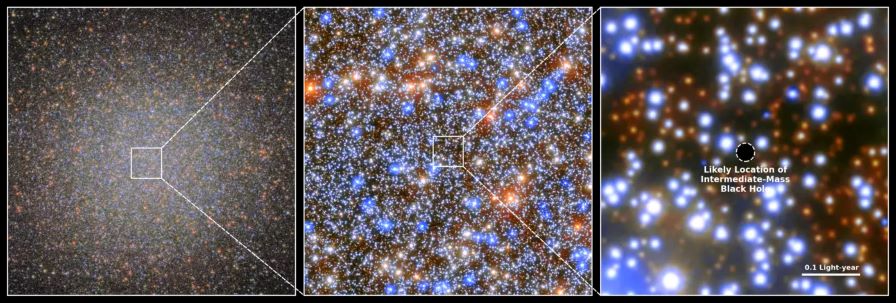[video] Astronomers discover closest massive black hole to Earth
Astronomers have found a black hole in the star cluster Omega Centauri, making it the nearest known massive black hole to our planet.
This black hole, with a mass of 8,200 Suns, fits into a category of intermediate-mass black holes, bridging the gap between smaller stellar black holes and the supermassive black holes found at galaxy centers, according to a press release from the Max Planck Institute for Astronomy.
Omega Centauri, which about 18,000 light-years from Earth, is likely the core of a small galaxy that merged with the Milky Way billions of years ago. Stripped of its outer stars, this nucleus has remained largely unchanged.
More to read:
Early Universe galaxies got killed by their supermassive black holes
For comparison, the Milky Way's central black hole is about 27,000 light-years away.

Omega Centauri is a cluster of about ten million stars, visible from the Southern Hemisphere.
Through telescopes, it appears similar to other globular clusters - a dense, spherical collection of stars.
Maximilian Häberle from the Max Planck Institute for Astronomy led the research team. By analyzing the motion of 1.4 million stars using over 500 images from the Hubble Space Telescope, Häberle identified seven fast-moving stars near the cluster's center. These stars' speeds point to the presence of a massive central object, identified as a black hole.
More to read:
Astronomers discover dwarf galaxy in the Milky Way neighborhood
The discovery provides a snapshot of a galaxy core frozen in time, helping to understand the evolution from small black holes in early galaxies to supermassive black holes. It not only confirms the presence of an intermediate-mass black hole in Omega Centauri but also strengthens the understanding of black hole evolution and the history of galaxy mergers.
The team plans to use the James Webb Space Telescope and other future instruments to study the black hole and the surrounding stars in greater detail. This will involve tracking the stars' movements to understand their orbits around the black hole.
The findings were published in the journal Nature. The research team included scientists from the Max Planck Institute for Astronomy, the University of Utah, and other institutions from Europe and South America.
A video illustrating the star cluster examination is available on YouTube.
***
NewsCafe relies in its reporting on research papers that need to be cracked down to average understanding. Some even need to be paid for. Help us pay for science reports to get more interesting stories. Use PayPal: office[at]rudeana.com or paypal.me/newscafeeu.




![[video] An invisible electric field envelopes Earth, unknown until now](/news_img/2024/09/01/news1_mediu.jpg)


